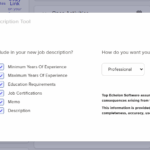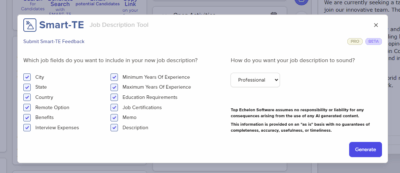(Editor’s note: The information from this article by Top Echelon Recruiting Software has been taken from an Expert Recruiter Coaching Series webinar by Greg Doersching of Next Level Training titled, “Candidate and Client ‘Ghosting’: Reality Check Time” Click HERE to watch the video of that training webinar for free.)
“Ghosting”—the sudden, unexplained disappearance of candidates or clients—has become a buzzword in the recruiting world. In fact, it’s become a go-to explanation when deals stall or fall apart. But is ghosting really a new epidemic, or is it just a convenient excuse masking deeper issues within our processes?
Let’s pull back the curtain and do what industry trainer and speaker Greg Doersching does best—bring some uncomfortable truth to the forefront and challenge recruiters to take a hard look at what’s really going on.
“Ghosting gives us a reasonable excuse for a lack of production. It allows us to deflect the blame from ourselves.”
What is Ghosting—Really?
Greg wastes no time cutting through the noise. Ghosting, at its core, is when a candidate or client stops communicating. That’s it. No mystical mystery. No elaborate explanation. Just silence.
But what’s more important is not what ghosting is, but why it’s become such a common complaint among recruiters. According to Greg, it’s not just about flaky candidates or aloof clients.
“It’s easier to point the finger than to ask ourselves how much of this we can actually control.”
Instead of stepping up to manage communication more effectively, build better rapport, or tighten up our process, we fall back on ghosting as the reason for missed placements.
The Psychology Behind Ghosting
There’s also a tendency to confuse ghosting with any behavior we don’t like. A candidate choosing another offer? Ghosting. A client delaying interviews? Ghosting. The reality is more nuanced.
Doersching introduces what he calls the “Negativity Principle.”
“We hang onto the negative. I talk to recruiters who bring up ghosting stories from years ago—as if they happened yesterday.”
We overinflate these experiences in our minds and use them as emotional safety nets when we underperform. That mindset must shift if we want to reduce ghosting and raise our production.
The Inescapable Truth: You Can’t Eliminate Ghosting
You’ll never completely stop candidates or clients from ghosting you. Some people will always choose to avoid conflict or accountability. The goal is not perfection—it’s minimization.
“There will always be people who think it’s easier to ignore you than face you.”
But we can dramatically reduce how often it happens by creating a professional, structured, expectation-driven recruiting process on both the client and candidate side.
Minimizing Client Ghosting
Let’s start with the client side. According to Greg, ghosting from clients—especially new ones—happens for a few key reasons. Here’s how you address it:
1. Only Work on Valid Searches
Before you even begin a search, schedule a dedicated intake conversation. Don’t do it on the fly. If a hiring manager brings up an opening, set a formal time to discuss it in detail.
“If you want to make sure you’re working on real work, people have to be able to be on time. They have to value your time.”
Use this time to include both HR and the hiring manager. When both are present, they hold each other accountable—reducing the likelihood of a communication breakdown later.
2. Establish Professional Control Points
Greg is a firm believer in inserting control points into the client relationship. One key tool is his “72-Hour Rule.”
“If a candidate doesn’t hear feedback within 72 hours, they assume the company isn’t interested—and you lose them.”
Educate your clients on the market. Explain that speed equals respect in the eyes of candidates. Make it clear you’ll give them 48 hours without follow-up—but after that, you’ll start chasing them for a response.
These early expectations build urgency and accountability into the process, minimizing ghosting later.
3. Roleplay and Recap
Before submitting candidates, Greg insists on role-playing the recruiting pitch with the client. Yes, it takes extra time. But it builds trust and positions you as an elite partner—not a resume pusher.
“Less than 2% of recruiters do this, but it tells the client you’re different. That you’re the expert.”
This extra touch shows you’re invested. It gives your client a say in how their opportunity is being presented and forces them to re-engage with the process.
4. Schedule Candidate Review in Advance
When the intake call ends, schedule your first candidate review session immediately—two weeks out, ideally on a Thursday. That gives you a built-in check-in.
“People don’t ghost people they have scheduled meetings with. Period.”
Doing it on a Thursday gives you time on Friday (planning day) to make adjustments if needed. Build these review sessions into your process every single time.
5. Act Like an Attorney
Professionalism matters. Ghosting often stems from clients feeling like you’re not taking the search seriously.
Greg’s solution? Create formal documents for every phase of the search. Send status updates, search summaries, and candidate debriefs—formatted and branded.
“The more professional you are, the more professional the client will be. People mimic the level of communication they receive.”
A weekly email that simply says “Just checking in, any feedback?” screams informality. Attach a status report. Use a template. Make it look like legal paperwork. You’ll earn their attention and their response.
Minimizing Candidate Ghosting
Candidate ghosting is a different beast, but the principles remain the same: structure, honesty, and mutual respect.
1. Be Honest from the Start
Too many recruiters hide the company name, vague-ball the role, and dodge money conversations out of fear.
“If you’re trying to protect yourself from bad things happening, you’re actually multiplying the chance of them happening.”
Greg’s recruiting conversations always begin with full disclosure: company, job title, pay range, and process.
2. Make It Their Choice
After sharing all the information, Greg gives the candidate space to think—and then makes the next step their decision.
“I don’t care what your answer is. Just make a decision. Pursue it or don’t. That’s your call.”
He sends a follow-up email with a job description and three screening questions. If they’re interested, they respond. If not, he moves on.
By creating an environment of mutual trust, candidates feel more accountable. It becomes harder for them to ghost because they’ve opted into the process on their terms.
3. Ask for Permission Before Presenting
This step is critical. After qualification, Greg always asks:
“Don, do you want me to present you to Grande Cheese for the Director of Engineering position?”
That yes creates psychological buy-in. The candidate has taken ownership. They’re less likely to ghost now because they’ve given their word.
Then Greg reinforces that bond:
“I’ll send you exactly what I send the client. You’ll see everything. I will always be guided by what’s in your best interest.”
This transparency is rare. And it builds trust that minimizes disappearance.
4. Don’t Play Games with Compensation
Nothing kills candidate trust faster than feeling manipulated about money. Greg never submits ranges. He submits exact numbers—clearly documented and agreed upon with the candidate.
“If a candidate feels like you’re playing games with compensation, they’re gone. Period.”
He confirms salary expectations again before final interviews—and sends a recap to both client and candidate to keep everyone aligned.
5. Use Phone Over Text for Key Moments
Scheduling interviews? Don’t just text. Call. Confirm details. Build rapport. Discuss compensation again. Re-emphasize motivation.
“You’re trying to build credibility. And you waste a perfect opportunity by handling it all through text?”
In a candidate-short market, trust and connection matter more than ever. Live conversations win over text exchanges every time.
Final Thoughts from Greg
You will never eliminate ghosting. But you can drastically reduce it—if you’re willing to own your process, tighten your structure, and elevate your communication.
“You’re the only one you can control in this equation. So control what you can.”
That means:
-
Qualify clients and candidates thoroughly
-
Set and enforce expectations
-
Follow a consistent process
-
Embrace honesty, even when it feels risky
-
Prioritize professionalism in every touchpoint
Don’t skip the steps. Greg’s process includes 31 specific actions for each search. Create checklists. Build cheat sheets. Add calendar reminders. Whatever it takes to stay sharp.
“Being a great recruiter is complicated. But it’s absolutely worth it. And now is the time to be great.”
Greg ended the webinar with a powerful reminder:
“The next five years are going to be the biggest boom time for recruiters since the dot-com era. You can be great at this. It’s simply up to you.”
Bottom line: Ghosting isn’t the enemy. A lack of process is. Master the process, own your communication, and you’ll become the recruiter clients and candidates never want to ghost again.









